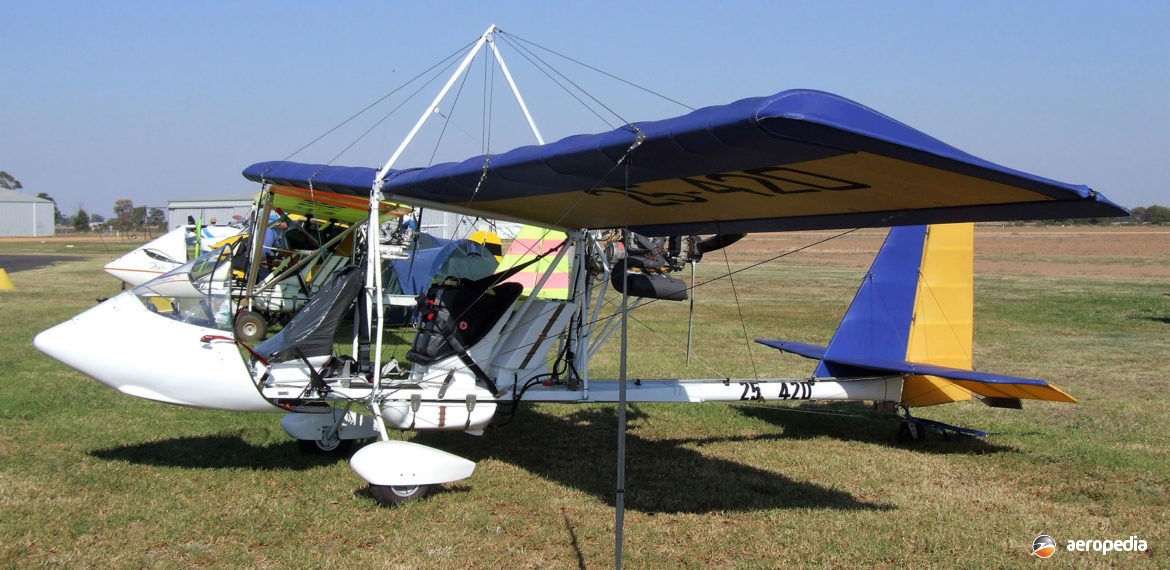Photograph:
Maxair Drifter 25-420 (c/n DR91-0414) at Narromine, NSW (David C Eyre)
Country of origin:
United States of America
Description:
Two-seat light sport aircraft
Power Plant:
One 48 kw (65 hp) Rotax 582 two-cylinder, two-stroke liquid cooled engine
Specifications:
- Wingspan: 9.14 m (30 ft)
- Length: 6.4 m (21 ft)
- Wing area: 13.93 m² (150 sq ft)
- Max speed: 137 km/h (85 mph)
- Cruising speed: 113 km/h (70 mph)
- Stalling speed: 61 km/h (38 mph)
- Rate of climb: 259 m/min (850 ft/min)
- Service ceiling: 5,486 m (18,000 ft)
- Range: 290 km (180 miles)
- Fuel capacity: 19 litres (4.21 Imp gals)
- Empty weight: 190 kg (420 lb)
- Loaded weight: 408 kg (900 lb)
History:
The Drifter is a single or two-seat light, open cockpit, aircraft usually registered under AUF / RAA rules and produced in a number of variants with a variety of engines. Originally marketed by Maxair in the United States with a Rotax 277 geared engine, in more recent times it has been available from Leza-Lockwood Corp of Sebring, Florida in the United States, from Thruster Air Services Ltd in the United Kingdom, and from Austflight, which constructed the type at its Boonah facility in Queensland and at Ballina, NSW. In Australia it was available in the 1980s with a Kawasaki 440 engine of 28 kw (38 hp) and was produced in single and two-seat variants. It met ANO 95.10 and ANO 95.25 regulations.
The Drifter in its DR-277 form was a wire-braced double-surfaced monoplane with a pusher engine mounted mid-fuselage on the carry-through boom, on which the pilot seat and the tail were mounted. The undercarriage was of the tailwheel type with tubular spring-steel main legs and a steerable tail wheel. The aircraft had full span ailerons and the leading edge behind and above the pilot gave good visibility. The XP-503 was a two seat variant and fell into the ANO 95.25 regulation. A three-seat variant was at one stage available in the United States.
Variants available include the Drifter XP503 with a 37 kw (50 hp) Rotax 503 engine; the Drifter MU582 with the 48 kw (65 hp) Rotax 582 engine; and the Super Drifter with the 60 kw (81 hp) Rotax 912 engine, the latter having flaps and disk brakes as standard, and a gross weight of 454 kg (1,000 lb). One variant is the Tiger Aviation Drifter SB which seats two in tandem and is fitted with a 48 kw (64 hp) Rotax 582 engine or the 60 kw (80 hp) Jabiru 2200 unit, this model having a gross weight of 499 kg (1,100 lb). The Lockwood Super Drifter has the 60 kw (80 hp) Rotax 912 engine and is intended for the amphibious role.
In 2000 the Australian manufacturer, Austflight, fitted a two-seat example with the Australian designed and built 60 kw (80 hp) Jabiru four-cylinder (2,200-cc) engine, this model becoming known as the JA-22. First of the type placed on the civil aircraft register was c/n DR98-1052SB, a Drifter JA-22, which became VH-AVR with Austflight Management of Kenmore, QLD in October 2000.
The Drifter’s standard features include dual controls, tandem seating, three-axis controls, cable bracing and a centre mounted joy-stick. Floats, or an agricultural spraying kit may be installed. Further information has become available in relation to the Drifter and it seems a number were built, presumably under licence, by Seabird Aviation at Hervey Bay, QLD and these came out of the Company’s facility with Seabird Drifter on the forward fuselage.
The Australian CASA certified the type with the Rotax 503, 582 and 912 engines. Development led to the SB (strut braced) variant designed to meet CAO 101.55 regulations in December 1993, this model being sold in the United States in the 1990s by Tiger Aviation of Trenton, South Carolina. It appears at least some 500 examples were completed.
In 1995 a joint venture was entered between Shangai Fenton Light Aircraft Company and Shangai Aircraft Manufacturing Company to manufacture aircraft in China. At about this time Austflight had financial difficulties. In May 2002 the assetts of the Australian manufacturer were sold to Noosa Air Pty Ltd. The type certificate was taken over by Drifter Aircraft Pty Ltd of Dalby, QLD in 2006 and this Company was issued with the production certificate by CASA.

